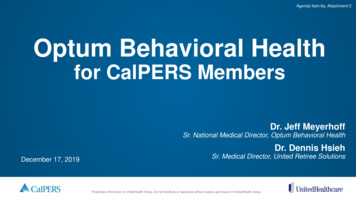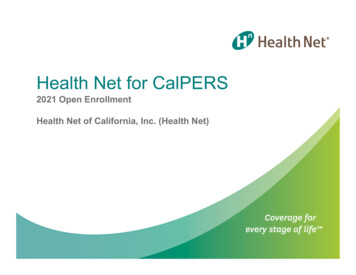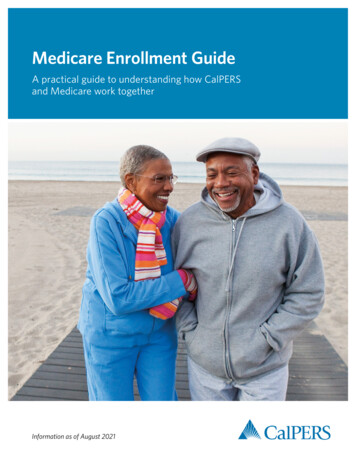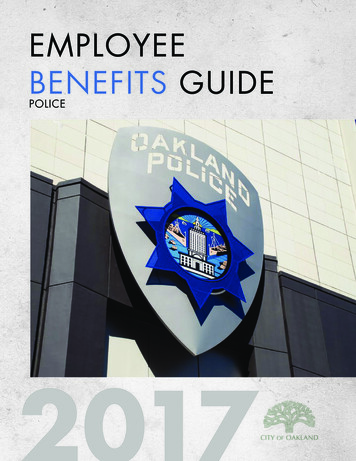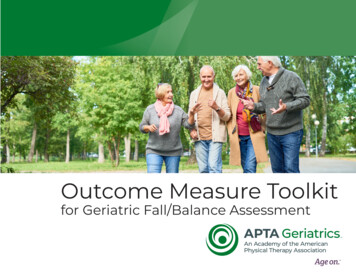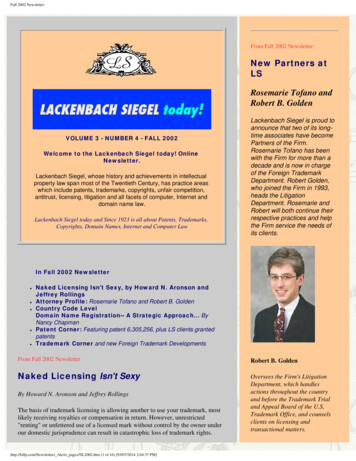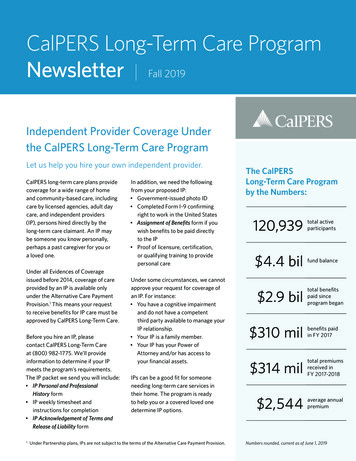
Transcription
CalPERS Long-Term Care ProgramNewsletter Fall 2019Independent Provider Coverage Underthe CalPERS Long-Term Care ProgramLet us help you hire your own independent provider.CalPERS long-term care plans providecoverage for a wide range of homeand community-based care, includingcare by licensed agencies, adult daycare, and independent providers(IP), persons hired directly by thelong-term care claimant. An IP maybe someone you know personally,perhaps a past caregiver for you ora loved one.Under all Evidences of Coverageissued before 2014, coverage of careprovided by an IP is available onlyunder the Alternative Care PaymentProvision.1 This means your requestto receive benefits for IP care must beapproved by CalPERS Long-Term Care.Before you hire an IP, pleasecontact CalPERS Long-Term Careat (800) 982-1775. We’ll provideinformation to determine if your IPmeets the program’s requirements.The IP packet we send you will include: IP Personal and ProfessionalHistory form IP weekly timesheet andinstructions for completion IP Acknowledgement of Terms andRelease of Liability form1In addition, we need the followingfrom your proposed IP: Government-issued photo ID Completed Form I-9 confirmingright to work in the United States Assignment of Benefits form if youwish benefits to be paid directlyto the IP Proof of licensure, certification,or qualifying training to providepersonal careUnder some circumstances, we cannotapprove your request for coverage ofan IP. For instance: You have a cognitive impairmentand do not have a competentthird party available to manage yourIP relationship. Your IP is a family member. Your IP has your Power ofAttorney and/or has access toyour financial assets.IPs can be a good fit for someoneneeding long-term care services intheir home. The program is readyto help you or a covered loved onedetermine IP options.Under Partnership plans, IPs are not subject to the terms of the Alternative Care Payment Provision.The CalPERSLong-Term Care Programby the Numbers:120,939total activeparticipants 4.4 bilfund balance 2.9 biltotal benefitspaid sinceprogram began 310 milbenefits paidin FY 2017 314 miltotal premiumsreceived inFY 2017-2018 2,544average annualpremiumNumbers rounded, current as of June 1, 2019
How to File a Claim forLong-Term Care BenefitsAs soon as you or a covered loved one requires formal (paid) long-term care (LTC) services, even if you have not initiatedservices, contact us and let us know. Starting a claim is as easy as a phone call.Getting startedCall customer service at(800) 982-1775, Monday throughFriday, 8 a.m.–5 p.m. Once you havegiven us authority to proceed withyour claim, the process is designedto minimize the need for informationfrom you.Intake callConducted with you or yourauthorized representative, this callestablishes why LTC services arerequired and where you hope to receivethose services—at home or in a LTCfacility. It’s an important opportunityfor you and your loved ones to fullyunderstand program benefits andthe claim process. The call lastsabout 20 minutes, scheduled atyour convenience.Fill out a claim formNext we’ll send you a claimpacket, which includes a Claim andMedical Records Authorization form.While the claim packet is an importantpart of the claim process, we willprocess as much of your claim requestas possible before you submit thisform. If your legal representativesigns the form for you, we needdocumentation of a power of attorney,guardianship, or conservatorship.In-person assessment andprovider informationIf the claimant is currently at home orplanning to receive care at home, we2arrange for an in-person assessmentof care needs, conducted by aregistered nurse. We may performthis assessment if the claimant hasmoved into or plans to move intoan assisted living facility, as well.We make all arrangements for theassessment, conducted at the timemost convenient for the claimant. Wepay all costs.In some cases, for instance, if youare in a nursing home, an in-personassessment will not be necessary.We rely on information from yourcare providers and/or physician.Provider andphysician recordsIf we need additional records, wewill use your signed authorization torequest them. You will be notifiedany time we make such requests andadvised of any delays in receiving them.We will notify youA care advisor will objectivelyreview your claim information todetermine your eligibility for benefits(the “Conditions for Receiving Benefits”in your Evidence of Coverage). Thisprocess normally takes two to fourweeks, depending how quickly we cansecure the information supporting yourclaim. When the determination is made,we notify you or your legal representative,both by telephone and in writing. Ifapproved, the care advisor will workwith you to establish the Plan of Care.Fall 2019If we determine you are ineligible, wewill call you or your legal representativeand send a letter of explanation. Youhave the right to ask for reconsiderationor to appeal this decision; this processis explained in the letter.Your deductible periodAfter you first meet benefiteligibility requirements, a certainamount of time must elapse beforebenefit payments begin. This is yourdeductible period (also called theelimination period). For most CalPERSparticipants, the deductible period is90 days.In most cases, the deductible periodbegins on the first date you receiveLTC services. Documentation,including the provider’s invoice, planof care, and daily care notes, must besubmitted to us. At this point, it is notnecessary to continue receiving paidLTC services for the remainder of thisperiod as long as you continue to meetthe eligibility requirements.Receiving benefitsDepending on the type of LTCservices, we will let you know whatdocumentation is needed to receivebenefit payments.
Introducing the LIFT WellnessTMProgram, launching Fall 2019An innovative approach to preventing falls and improving strength.Falls are the most common causeof injury among older adults. One inthree adults age 65 and older has a falleach year, according to the Centersfor Disease Control (CDC). Roughly27,000 people in this age group diefrom fall-related injuries annually.CalPERS is striving to help preventthese serious health issues, incollaboration with our long-termcare policy administrator, LTCG.Together, your health and safetyare our top priority.LTCG has developed an innovativeprogram to prevent falls. Launchingthis fall, the LIFT Wellness Program isdesigned to promote wellness and helppeople remain in their homes as longas possible. It will initially be availableto a select group of policyholders whoqualify based on their age and otherfactors. If you do qualify, this excitingprogram is provided to you at no costand will give you access to ongoingsupport and resources designed topromote your health and safety.The LIFT Wellness Program is basedon the latest medical research in fallprevention. LIFT has already deliveredresults that reduce the rate of fallsand significantly lower long-termcare claims costs; policyholders canmaximize their benefits because theywon’t have claims for avoidable falls orrelated health issues.How the program worksThe LIFT Wellness Program offerscompassionate support from highlytrained health coaches. This outreachis personalized based on specificinformation about each participant’srisk factors and health issues. Keycomponents of LIFT include: A specially designed in-homeassessment by a skilled nurseassessor. One-on-one telephonic supportfrom LIFT health coaches. Thisbegins with a review of eachparticipant’s health, psychosocial,functional, and cognitive status,plus a medication reconciliationFall 2019of all prescription and over-thecounter drugs a participant istaking. Each person’s unique needsdetermine the number of calls andlength of outreach. A personalized action plan,including tailored goals for eachparticipant based on the results ofthe in-home assessment. The planis shared with the individual andtheir physician. An engagement toolkit mailedto your home. This kit includeseducational materials and toolsdesigned to promote home safety,fitness/strength, and specific areasof health improvement that impactfall prevention.Learn more about LIFTIf you are 75 years or older, you mayqualify for CalPERS LIFT WellnessProgram. For more information and toschedule an appointment, go towww.lift-wellness.com. Enter thecampaign code “CAL000” so we knowhow you learned about the LIFT program.3
5 Healthy Strategies forDementia PreventionA healthy lifestyle impacts more than your physicalhealth. Your brain will thank you, too.Dementia is the number one causeof claims paid by the CalPERS LongTerm Care Program. We help providerelief to families who incur significantexpenses due to these illnesses.Today, more than 5.8 millionAmericans are living with dementia.By 2050, that number is projected toincrease to 14 million, according to theAlzheimer’s Association. Though wecan’t stop the aging process and a curefor dementia has yet to be identified,scientific evidence suggests you canreduce your risk of cognitive declinethrough key lifestyle changes.Focus on your risk factorsHigh blood pressure, diabetes, andhigh cholesterol increase the riskof cardiovascular disease and ofdeveloping Alzheimer's. Researchshows that as many as 80 percent ofindividuals with Alzheimer's also havecardiovascular disease, which may playa role in the development of plaquesand tangles often seen in Alzheimer’sand other forms of dementia.Smoking and excessive alcohol useare also risk factors for dementia.4Controlling these habits may helpforestall the onset of dementia.Improve your dietEat heart-healthy, limit sugar andsaturated fats, and increase intake offruits, vegetables, and whole grains.Both the Dietary Approaches toStop Hypertension (DASH) diet andthe Mediterranean diet have beenassociated with improved cognitiveabilities and may be an effectivepreventive measure to maintaincognitive health.Increase your physical exerciseRegular physical exercise helps lowerthe risk of Alzheimer's and vasculardementia. Researchers believe thatexercise can directly benefit brain cellsby increasing blood and oxygen flowin the brain. A medically approvedexercise program is a valuable part ofany overall wellness plan.Keep it socialResearch studies have shown thatmaintaining strong social connectionsand keeping mentally active as we ageFall 2019might lower the risk of cognitive declineand Alzheimer's. Mental exercises,such as learning an instrument or a newlanguage, are associated with a lowerrisk of developing a dementing illness.Some researchers postulate that socialconnections and mental stimulationmay actually strengthen connectionsbetween nerve cells in the brain.Prevent head injuriesRecent research shows a strong linkbetween serious head trauma andfuture risk of Alzheimer's. Protectyour head. Wear a seat belt, use ahelmet when riding a bike, and identifyfall risks by removing throw rugs,adding hall and bathroom lighting, andinstalling grab bars in your bathroom.Join a gym or a fall prevention programto work on your balance and strength.There are many benefits to creatinga healthy lifestyle. These choicescan improve your health and protectyour brain.Learn more about preventivestrategies through the Alzheimer’sAssociation. Check out “10 Ways toLove Your Brain” at www.alz.org.
The Importance of MedicationManagement for the ElderlyPrioritizing medication management can prolongyour independence.Managing your medications, whetherover-the-counter or prescribed, is criticalnot just to the successful treatment ofdisease and injury but also to helpingyou remain safely at home as you age.Every year in the United States, anestimated 3 million elderly adults areadmitted to nursing homes becauseof medication errors and interactions,including taking incorrect amounts,missing dosages, and continuing totake medications a physician hasreplaced.1 Older adults who areprescribed more than five drugs upondischarge from a hospital stay areat increased risk of ER visits and/or hospital readmission within sixmonths. 2 Many medications areassociated with increases in falls,injuries, and loss of independence, andshould be avoided whenever possible.settings have kept medications oneor more years after they were lastprescribed by a physician. 3 Many failto advise their primary physician ofmedication prescribed to them byother physicians or of over-the-countermedications they’ve elected.are taking, especially new ones youmay not be familiar with. Keep a list of your medications anddosages in your wallet. Ask your pharmacist for “friendly”medication packaging, such as easyopen bottles and large print labels.EducationManaging your medication effectivelyis critical to remaining functional andindependent as you age.Learn why a medication was prescribed,its side effects, the consequences oftaking too much or too little, as wellas interactions with other drugs orfood. Medications may require dietarychanges, regular laboratory follow-up,be intended for short term use, orrequire adjustments in dosage over time. Read the inserts provided with yourmedication. Tell your designated power ofattorney about any medications you1Johnson JA, Bootman JL. Drug-relatedmorbidity and mortality. A cost-of-illnessmodel. Arch Intern Med. 1995;155(18):1949–56.2Alarcon T, Barcena A, Gonzalez-Montalvo JI, etal. Factors predictive of outcome on admissionto an acute geriatric ward. Age Ageing.1999;28:429–32.3Bevil CW. Medication management in an elderly,community-based population: a pilot project. JNY State Nurses Assoc. 1981;12(2):19–29.A weekly pill box to organize yourmedications will help lower the risk ofmedication mistakes. Consider bubblepacks, i.e., medications organizedin daily envelopes by the pharmacy,which have dramatically reducedmedication errors.How else can you minimize your risk?Medication reconciliationThe first step to reduce the riskof medication mismanagementis to make sure you keep only themedications currently prescribed byyour physician. Nearly half of olderadults living outside institutionalFall 20195
Home Safety for Loved Ones with DementiaFrom deadbolts to night lights, these simple solutionscan prevent accidents.Alzheimer’s type dementia and otherforms of cognitive impairment areprogressive, degenerative neurologicalconditions that impact individuals andmay put their safety at risk.JudgmentThe following strategies can helprelieve some of the consequences ofdementia for you or your loved ones.Sense of time and placeForgetting how to safely use household appliances, medications, and tools Remove or disable appliances that might prove dangerous, such as microwave, stove,and electric knife, and remove knobs from the stove. Rearrange kitchen supplies to remove access to knives or breakable glasses.Getting lost in one's own home, street, and community Place large-print labels, like “toilet” on the bathroom door, “socks” on the dresserdrawer, “cups” on the cabinet door. Enroll your loved one in the Safe Return program through the Alzheimer’sAssociation, at www.alz.org.Physical abilityTrouble with balance, gait, and depth perception, which can lead to falls Put decorative stickers on sliding doors to minimize the risk of walking into glass. Add textured stickers to slippery surfaces and apply adhesives to keep necessarythrow rugs and carpeting in place.SensesChanges in vision, hearing, and touch Turn down the hot water tank temperature. Use night lights and motion-detected lighting in and outside the home.WanderingAccess additional safety tips bycalling your local Alzheimer’sAssociation office or visitingwww.alz.org.6Six in 10 people with dementia will wander Place deadbolts and alarms either high or low on exterior doors. Enable the “find phone” feature on the individual’s mobile phone. Obstruct access to even small bodies of water near or around the home.Fall 2019
We have resources to help you plan and manage yourlong-term care needs, stay informed about changes inour Long-Term Care Program, and information aboutlong-term care in general.Contact the CalPERS LTC ProgramOnline ResourcesThe CalPERS Long-Term Care Programis administered by LTCG.California Department of Agingwww.aging.ca.govCalPERS Long-Term Care ProgramNational Association of Area Agencies on tional Institute on Aging Information .S. Department of Health and Human ServicesLong-Term Carewww.longtermcare.govMonday through Friday, 8:00 a.m.–6:00 p.m. PSTCurrent participants: (800) 982-1775Prospective applicants: (800) 908-9119Provider services: (888) 396-5824Employers: (800) 845-8427Family Caregiver Alliancewww.caregiver.orgFaxAmerican Association for Long-TermCare Insurancewww.aaltci.orgCustomer service: (952) 833-5417Claims: (866) 294-6967Participant services: (866) 294-6966Prospective applicants: (952) 918-5089National Alliance for Caregivingwww.caregiving.orgMailCaregiver Action Networkwww.caregiveraction.orgGeneral correspondence:CalPERS Long-Term Care ProgramP.O. Box 64902St. Paul, MN 55164-0902Well Spouse Associationwww.wellspouse.orgOvernight mail:CalPERS Long-Term Care Program7805 Hudson Road, Suite 180Woodbury, MN 55125-1591Alzheimer’s Associationwww.alz.orgAlzheimer information from U.S. Departmentof Health and Human Serviceswww.alzheimers.govPremium payments:CalPERS Long-Term Care ProgramDepartment LA 21217Pasadena, CA 91185-1217Silver Brick Roadwww.SilverBrick.comFall 20197
CalPERS Long-Term Care Program AdministratorP.O. Box 64902St. Paul, MN 55164–0902CalPERS Long-Term Care Program Newsletter Fall 2019INSIDE THIS ISSUE:Independent Provider Coverage Underthe CalPERS Long-Term Care Program . . . . . . 1How to File a Claim forLong-Term CareBenefits » page 2How to File a Claim for Long-Term Care Benefits . 2Introducing the LIFT WellnessTM Program . . . . . 35 Healthy Strategies for Dementia Prevention . . . 4The Importance of Medication Managementfor the Eldery . . . . . . . . . . . . . . . . . . . . . . 5Home Safety for Loved Ones with Dementia . . . . . 6Resources . . . . . . . . . . . . . . . . . . . . . . . . . . . . . . . . . . . . 7
Before you hire an IP, please contact CalPERS Long-Term Care at (800) 982-1775. We'll provide information to determine if your IP meets the program's requirements. The IP packet we send you will include: IP Personal and Professional History. form IP weekly timesheet and instructions for completion IP Acknowledgement of Terms and


